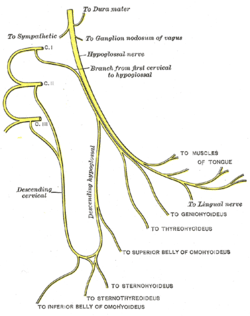Inferior ganglion of vagus nerve
| Inferior ganglion of vagus nerve | |
|---|---|
 Plan of upper portions of glossopharyngeal, vagus, and accessory nerves ("Gang. nodosum" visible at center) | |
| Details | |
| From | vagus nerve |
| Identifiers | |
| Latin |
Ganglion nodosum, ganglion inferius nervi vagi |
| MeSH | A08.340.390.550 |
| TA | A14.2.01.157 |
The inferior ganglion of vagus nerve, or nodose ganglion (ganglion nodosum; ) is cylindrical in form, of a reddish color, and 2.5 cm (0.98 in) in length. It is located in the height of the transverse process of the first cervical vertebra (atlas).
Passing through it is the cranial portion of the accessory nerve, which blends with the vagus nerve below the ganglion.
The inferior ganglion is larger than the superior ganglion.
Function
It is chiefly visceral afferent in function concerning sensation of heart, larynx, lungs and alimentary tract from the pharynx to the transverse colon. These visceral afferents synapse centrally in the solitary nucleus.
Both ganglia are traversed by parasympathetic, and perhaps some sympathetic fibres.
Preganglionic motor fibres (ganglionic branches) from the dorsal vagal nucleus and the special visceral efferents from the nucleus ambiguus, which descend to the inferior ganglion of vagus nerve, form a band skirting the ganglion.
Additional images
 Plan of hypoglossal nerve.
Plan of hypoglossal nerve.
References
This article incorporates text in the public domain from the 20th edition of Gray's Anatomy (1918)
External links
- cranialnerves at The Anatomy Lesson by Wesley Norman (Georgetown University) (X)